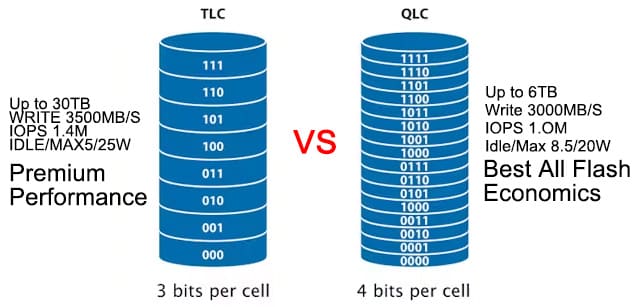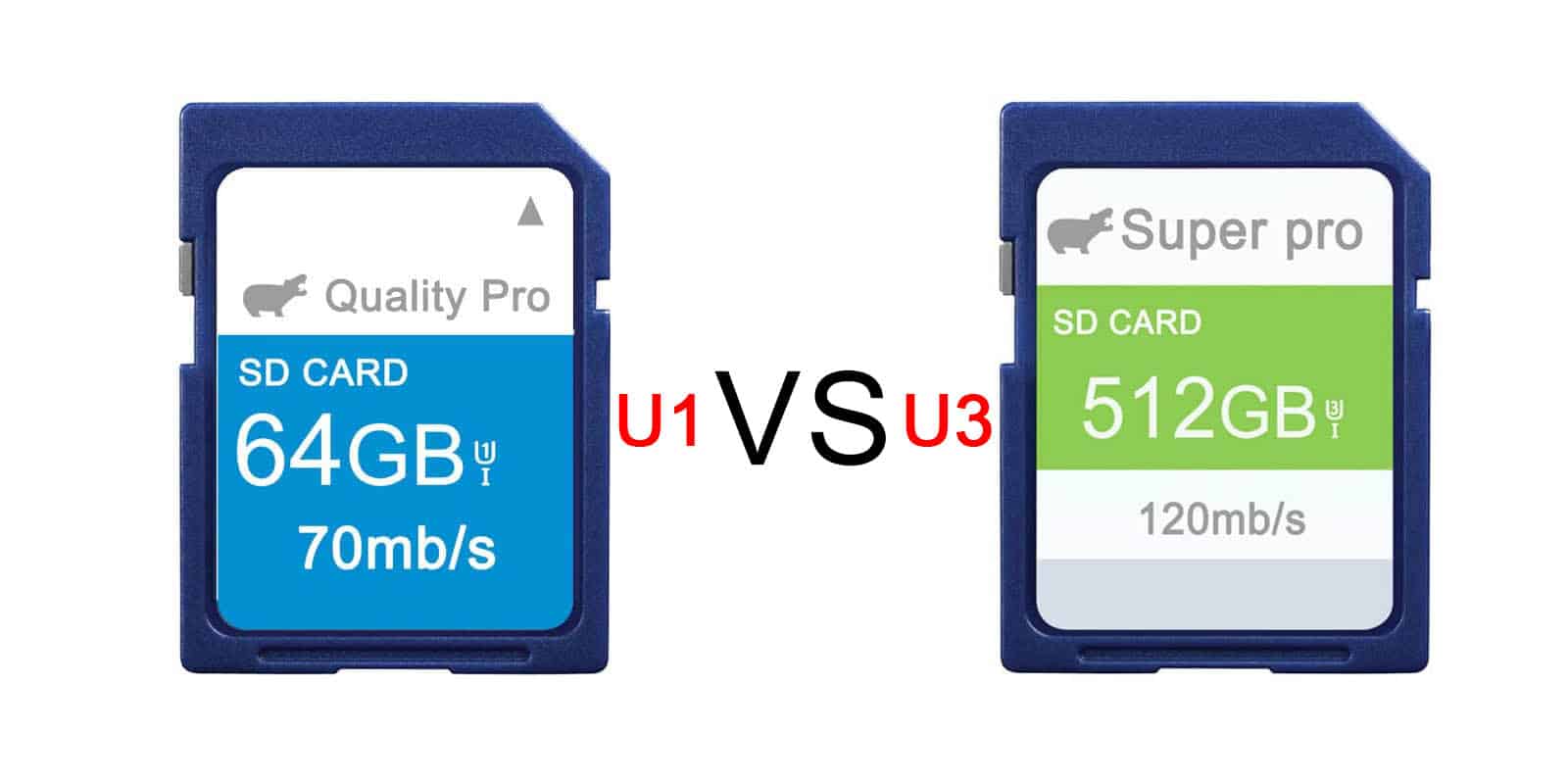Latest Posts
Which is Better: TLC vs QLC?
TLC vs QLC: A Quick Overview
TLC VS QLC, TLC and QLC are types of NAND flash memory. They store data in cells, with each cell holding multiple bits. The more bits in a cell, the more storage capacity, but can slow down performance and reduce durability.
- Triple-Level Cell holds 3 bits per cell, balancing capacity, price, and speed. It’s commonly used in SSDs and memory cards for general consumers.
- Quad-Level Cell stores 4 bits per cell, offering larger storage at a lower price. But, this increased capacity comes with some trade-offs in performance and longevity.
This write-up compares both, showing you which is best for your device—like an SSD, SD card, or laptop upgrade.
Key Differences Between TLC and QLC
TLC and QLC flash storage vary in many ways, from cost to capacity and speed.

Cost
TLC and QLC NAND flash have a notable cost difference. With QLC storing four bits per cell, it’s generally cheaper than TLC, which only holds three bits. This extra data capacity in QLC lets manufacturers reduce production costs, allowing more storage in the same space.
However, QLC’s lower cost often means reduced speed and durability. For those seeking affordable, high-capacity storage, like for media libraries, QLC can be a solid choice. But, for high-performance or long-lasting storage, QLC’s compromises may not be worth the savings.
TLC VS QLC Lifespan and Durability
With three bits per cell, TLC is more durable than QLC, which holds four. This extra bit in QLC causes cells to wear down faster under frequent use. TLC handles more write-and-erase cycles and performs well under heavy tasks like gaming or workstation applications. QLC, in contrast, is ideal for data that is mostly read and rarely changed.
TLC VS QLC Speed and Performance
TLC tends to outperform QLC in speed and performance. It’s faster because it uses three bits per cell, making data processing quicker with less voltage consumption. This is especially noticeable in tasks like video editing, gaming, and software development, where frequent data writing is required.
TLC’s faster write speeds enhance both efficiency and overall experience. On the other hand, QLC is slower and might not handle demanding tasks well, but it works fine for basic storage like photos or media files.
TLC VS QLC Storage Capacity
QLC drives are great for those who need large storage. With the ability to store four bits per cell, it achieves high density and offers massive storage capacities, often reaching 4TB or more, all at a lower price than comparable TLC drives. This makes QLC a strong contender for archiving and backup needs.
Other Differences to Keep in Mind
- Power Use: TLC consumes more power because it stores three bits per cell. For most users, the difference isn’t significant.
- Heat: TLC generally creates less heat because it handles more write cycles without issue. QLC, due to its denser cells, may struggle with heat over time.
- Endurance and Use: TLC is more durable and works better across various tasks. QLC is ideal for light tasks like storing large files or backups where frequent writes aren’t required.
Relationship Between NAND Flash Types and Memory Cards
The performance of SSDs, SD cards, and microSD cards depends largely on the NAND flash type. SLC, TLC, and QLC each have their unique effects.
MicroSD Cards
- TLC Flash: More durable and faster, making it ideal for tasks with frequent writes like 4K video recording and high-speed photography. It offers better performance and reliability.
- QLC Flash: More affordable but slower and less durable. Best for storage-heavy tasks like media backups or long-term storage, but not suitable for high-performance needs.
SSDs
- TLC Flash: Offers a balance between price and performance, with solid read/write speeds and better durability than QLC. Great for general computing, gaming, and applications.
- QLC Flash: Cheaper but slower and less durable. Best for more storage needs like data archiving or home servers, but not recommended for high-demand tasks.
SD Cards
- TLC SD Cards: Best for 4K video or high-resolution images, offering fast write speeds and good durability for professional use.
- QLC SD Cards: Suitable for basic storage needs, like casual photography or personal use, where speed and frequent writes aren’t crucial.
TLC vs QLC: A Quick Comparison
Best Use Cases for TLC
TLC is ideal for users who need a balance between performance and reliability. It handles fast data access and long-term durability well, making it great for demanding tasks.
For gamers, TLC’s fast read and write speeds ensure smooth gameplay and quick load times. Professionals working on video editing or 3D rendering will find TLC’s ability to manage frequent large data transfers helpful. Content creators can rely on TLC for large, high-resolution files.
While TLC is more expensive than QLC, its consistent performance and durability make it a good investment if you need reliable storage for heavy tasks.
Best Use Cases for QLC
QLC memory caters to users needing substantial storage on a budget. It provides plenty of room but sacrifices speed, making it less ideal for users with high-performance needs.
QLC shines in media storage, offering plenty of room for large files like videos and photos at a lower price. It’s perfect for backups or casual storage needs, where speed isn’t as critical. If you’re doing lighter tasks or just need storage for everyday files, QLC is a solid choice.
Performance Benchmarks
TLC drives typically offer write speeds of around 500–550 MB/s. These speeds make TLC suitable for gaming, video editing, and handling large files easily.
QLC drives are generally slower, with write speeds between 300 and 500 MB/s. While this is slower, it’s fine for everyday tasks like file storage or light editing. However, frequent large file writes could slow things down. For users prioritizing heavy writes or long-term reliability, TLC is better. But for those who need bulk storage on a budget, QLC still delivers.
Future of NAND Flash
As storage demands rise, the NAND flash industry is adapting quickly. QLC (Quad-Level Cell) is gaining traction, with improved speed, durability, and efficiency shaping its future in the consumer market.
One advancement is 3D NAND stacking. This technology increases storage capacity while improving efficiency and lifespan by stacking memory cells vertically. The stacked structure reduces wear on cells during read/write operations, helping extend the life of devices like SSDs and microSD cards.
3D NAND stacking enables QLC to offer larger capacities without compromising performance. Additionally, better wear leveling and error correction algorithms are helping close the gap between QLC and TLC (Triple-Level Cell), making QLC a solid choice for budget-conscious consumers.
Final Words
The right option depends on your needs.
- Choose TLC for reliable, long-lasting performance and faster speeds for tasks like gaming or video editing.
- QLC is a good budget option if you need a lot of storage. It’s slower and not as durable, but it’s enough for tasks like archiving or media storage.
|
Factor |
TLC (Triple-Level Cell) |
QLC (Quad-Level Cell) |
|
Cost |
Higher, but offers better performance and durability. |
More affordable, ideal for large storage needs. |
|
Lifespan |
Longer lifespan, good for frequent write-heavy tasks. |
Shorter lifespan, not ideal for high-write environments. |
|
Speed |
Faster read and write speeds, suitable for performance tasks. |
Slower performance, better for light read/write use. |
|
Storage Capacity |
Lower storage density compared to QLC. |
Higher storage density, great for large capacity needs. |
|
Best For |
Gaming, video editing, OS drives, and frequent data writes. |
Backups, media storage, and light usage. |











Leave a comment